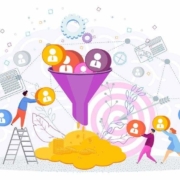Senior Living Marketing Channels: Which Ones Matter in 2021?
Which senior living marketing channels do the majority of your prospects hang out on today? Let’s keep it high level and discuss the big three umbrellas: Search, Social, and Email.
Senior Living Marketing Channel #1: The Search Is Over.
Who would have thunk when Google was founded in 1998 that it would take over in the way it has? Today, “google” is a verb, and it’s the first thing we all do when we’re searching for anything online, whether it’s a new place to eat, a new car to buy, or a new place to live, like a senior living community.
Sure, how your prospects get to you via search might not always be a straight line. Some searchers might come from review sites. Others from directories. Still others from your Google My Business listing or social media. And, of course, some will land on your website first and explore the above after. But it all starts with search.
We’ve shared stats like these before, but they’re worth sharing again:
Over 6000 searches related to senior living communities are made each hour. [Source: Senior Housing News]
Baby Boomers spend more time online than Millennials, and a staggering 92% of Boomers shop online. [Source: The Shelf]
Boomers have great attention spans and will read your content! 60% of Boomers regularly read blogs, and 70% percent watch video content online. [Source: The Shelf]
Boomers are almost as likely as Millennials to own a tablet. [Source: Marketing Charts]
68% of Boomers own a smartphone. [Source: Pew Research Center]
Plenty of senior living marketing tasks come under the search umbrella, including the following:
- Optimizing your website and blog for search using relevant keywords that people are already plugging into Google
- Creating keyword-rich paid ads through Google AdWords
- Implementing retargeting ad campaigns (those ads that keep following you around wherever you go)
- Optimizing listings on review sites and Google My Business listings
Bottom line: Whenever you think about senior living marketing, you should always be thinking about it in relation to search. Optimizing your digital marketing for search should drive everything you do.
Senior Living Marketing Channel #2: Let’s get social.
Social media is an important channel to focus on now—for a few reasons.
First, your prospects are already hanging out on various social platforms. Consider the following breakdown for social media usage among Baby Boomers in the U.S. according to Statista.
- YouTube – 70%
- Facebook – 68%
- Pinterest – 27%
- LinkedIn – 24%
- Instagram – 23%
- Twitter – 17%
Second, consider the generations following Boomers—specifically Gen X and older Millennials. They’re even bigger social media users. So investing in social media marketing now makes sense. You’ll capture the Boomers who are active, and you’ll be poised to welcome the next generations as they start thinking about senior living for themselves.
Third, you can be a lot more casual on social media than you can in other places, like your website or Google My Business listing. You can be whimsical. You can even make a typo without anyone walking away thinking you’re unprofessional. Best of all, you can give a real sense of what your community is like.
As we often remind our clients, all senior living communities are selling the same thing. Differentiating yourself from the community down the street or the next town over involves pulling back the curtain and letting people see your community’s true “essence”—those little things that make it different, special, and that might inspire someone to call your community home. Social media is a great way to share your community’s essence.
Senior living marketing activities that fall under the social media umbrella include:
- Sharing engaging content designed for a particular channel. For example, great pics on Instagram or regular Facebook Live events.
- Taking advantage of a platform’s paid advertising capabilities. From boosting posts on Facebook to running ads on Instagram.
Check out this series we recently completed on senior living social media marketing.
Senior Living Marketing Channel #3: The death of email has been greatly exaggerated.
The adoption of smartphones and tablets is one of the main reasons why email is alive and well—and will remain so for the near future.
This article reports that email is a top three distribution channel for both b2b and b2c marketers, that over 4 billion people around the world used email in 2020, and that email has over a 90% penetration rate among US internet users. The same article notes that email remains the most reliable channel for nurturing and converting marketing-qualified leads to sales-qualified leads to actual customers.
Of course, the key to effective email marketing is making sure you have a smart strategy—and that you have good marketing automation that’ll help you execute that strategy. This involves understanding your prospects’ journeys so you can develop the right content for the right prospect and deliver it to them via email at the right time.
Remember, silo mentalities need not apply.
Don’t approach each senior living marketing channel as if it exists separately from the others. Instead, create one strategy that includes all three channels. Need help? You’ve come to the right place. Our strategic marketing roadmap is an excellent place to start.



